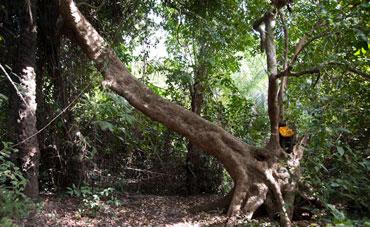 |
||

|
The Violet Turaco, Musophaga violacea; with open wings the scarlet of the flight-feathers is striking. Not wholly dependent on climax forest but certainly typical of it – the reason the bird was chosen locally for the logo of Farasuto Forest Community Nature Reserve |
Flora and the food-chain
Trees
In comparison with the remainder of the site’s flora the identification and mapping of trees is likely to be a shade more straightforward.
Inside the forest, with an ancient and rare tree specimen, roll your mouse over to appreciate the scale |
The number of tree species is probably less than that for other flowering plants and help has already been offered by the Western District Forest Department’s Eco-tourism Officer. The larger specimen trees should be relatively easy to list, number, measure, identify to species and map. A hand-held GPS unit has been donated to the group and during the dry season it should be possible to get signals through the forest canopy and determine precise positions for the larger trees. When the trees are identified and mapped it should be possible to assess their conservation importance – it is believed that some of the forest trees are significant rarities – time will tell.
Similarly it should be possible to use GPS to obtain exact locations for the larger ant-hill/termite mounds and other prominent features such as pathway junctions which will help produce a definitive map of the site, essential for the proposed Management Plan.
Other flora
The identification and cataloguing of the non-tree flowering plants, not to mention mosses and lichens, is a huge task and as yet there is no plan for how it will be achieved. While the more common plants, perhaps especially those with medicinal qualities, may already be known locally, there are bound to be many (probably the majority) which will need specialists to find and identify them. How this can be achieved is currently (in early 2009) unknown. However we can be assured that, just as the forest holds rare and special forest birds, so it will turn out that plant rarities will be discovered and may require special management in order to maintain them.
The importance of maintaining the diversity of the reserve’s flora cannot be over-emphasised – it is the basis of the food-chain for the entire site. This situation is especially relevant when considering the inter-dependency of food-plants and the many invertebrates – beetles, bugs and so much else besides – which reply on them. It must be remembered that many such creatures use only one kind of plant as food – so loose the plant and you loose the butterfly, or beetle, or bug and however many others which rely on eating it.
Food-plants and the food-chain: butterflies as an example
Adult butterflies rely mainly on nectar for the energy during their relatively short lives. This energy source is essential to them in finding a mate and for the females laying eggs. While some species use many different flowers some are very specific.
Most species are very choosy in their selection of, not only the species of caterpillar food-plant which is chosen but also which particular plant is selected and precisely where on the plant the egg is laid. Without that particular food-plant growing in the right place with the correct growth then no eggs will be laid and then that particular species of butterfly will become extinct in that locality.
The single butterfly example of this so far known from Farasuto is the Common Bush Blue Cacyreus lingeus which lays its eggs on the newly forming seed-pods, near the tip of the plant, on Rattlebox Crotolaris species (spectabilis?) (with acknowledgments to Mike Slater of Butterfly Conservation for this information). A member of the Kuloro Bird Club, Mamadou W Jallow, has begun to diversity into butterflies and may be able to help first listing Farasuto’s butterflies and even identifying their food-plants.
Towards the Management Plan
The intricacies of the plant-animal relationships within the remaining forests of the Gambia are probably currently little-known. However during the coming year as much as possible should be accumulated about the plants and the animals in the food-chain on the site.
Even if all the inter-relationships are not all understood, and they may never be, it will be essential to list as many as possible of the plants and animals, of all groups; butterflies, moths, beetles, dragonflies, snails, snakes, frogs, toads, rates and mice, bats – the list goes on. The author can add Black Mamba, Dendroaspis polyepis, to the list of snakes – a 1.2m one was seen in the forest on 20 January.
A year has initially been allocated for this process, collating all the evidence needed for describe the place, that is to assemble Part 1 of the Management Plan – into the start of 2010, prior to embarking on finishing the Plan 3, the Action Plan, at a later stage.



